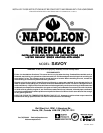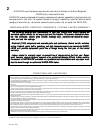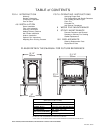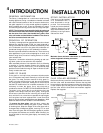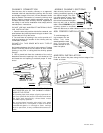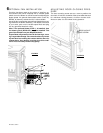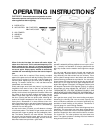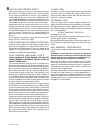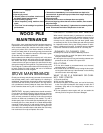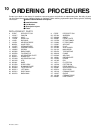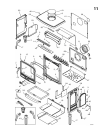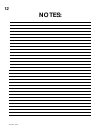8
W415-0257 / 08.02.01
FLASH FIRE:
A flash fire is a small fire burned quickly when you don't need
much heat. After your kindling has "caught", load at least 3
pieces of wood, stacked loosely. Burn with the draft control
fully open or closed only slightly.
EXTENDED FIRE:
Load your larger pieces of wood compactly, packed close
enough to prevent the flames from penetrating it completely.
After approximately 30 minutes, depending on the size of the
load, close the draft control completely making sure that the
fire is not extinguished.
DO NOT OVERFIRE THE STOVE!
Overfiring can occur by:
a) burning large amounts of smaller wood pieces such as
furniture scraps, skids or treated wood;
b) vigorously burning large loads of wood with the draft con-
trol on "HIGH" (fully open) for long periods of time (one or two
hours).
ASH REMOVAL PROCEDURES
It is essential to keep the grate free of a heavy build up of
ashes.
Remember to burn solid fuel correctly: air should be
allowed to flow from the ash pit area through the grate
and through the fuel. If the grate or ash pan are con-
gested, the burn performance will be effected.
When burning solid fuel, always empty the ash pan at least
once a day or whenever it is full of ashes. Never allow the
ashpan to overfill thereby allowing ash to be in contact with
the underside of the grate. If this condition is allowed, the
grate will wear out prematurely.
Hot ashes may be kept in a metal container with a tight fitting
lid. Keep the closed container on a noncombustible floor or
ground, well away from all combustible materials. The ashes
should be retained in the closed container until all cinders
have thoroughly cooled. Cold wood ashes can be used on
the garden or in the compost.
ACHIEVING PROPER DRAFT
Draft is the force which moves air from the stove up through
the chimney. The amount of draft in your chimney depends
on the length and diameter of chimney, local geography,
nearby obstructions and other factors. Adjusting the air
control (Item B - Figure 11) regulates the temperature. The
draft can be adjusted from a low burn rate with the control
fully closed, to a fast burn rate with the control fully open.
Inadequate draft may cause back-puffing into the room
through the stove and chimney connector points and may
cause plugging of the chimney. Too much draft may cause
an excessive temperature in the stove, glowing red stove
parts or chimney connectors or an uncontrollable burn
which can lead to a chimney fire or permanent damage to
the unit.
Do not operate your stove for longer than 30 minutes with
the air control on "HIGH" (fully open).
FIRE EXTINGUISHERS / SMOKE DETECTORS
All homes with a solid fuel burning fireplace should have at
least one fire extinguisher in a central location known to all,
and at least one smoke detector in the room containing the
fireplace. If it sounds an alarm, correct the cause but do not
deactivate or relocate the smoke detector.
FUEL LOADING AND BURN CYCLE
WHEN LOADING THE STOVE, ENSURE THAT THE TWO
UPPER COURSES OF FIREBRICK ARE NOT LIFTED UP
AND OFF THEIR LEDGE.
For maximum efficiency, when the stove is thoroughly hot,
load it fully to the top of the door opening and burn at a me-
dium low setting. Maximum heat for minimum fuel (optimum
burn) occurs when the stove top temperature is between
500°F (260°C) and 600°F (315°C). The bricks will be nearly
all white and the glass mostly clear. The whiteness of the
bricks and the cleanness of the glass are good indicators of
your operating efficiency. Not enough heat is produced when
only one or two pieces of wood are burned or the wood may
not burn completely. A minimum of three pieces are needed
to encase a bed of coals that sustains the fire.
Loosely stacked wood burns quicker than a tightly packed
load. Wood burns in cycles rather than giving a steady output
of heat. It is best to plan these cycles around your household
routine so that only enough coals are left to start the next load.
In the evening, load your stove, at least, a half-hour before
bed to ensure a good fire, hot enough to close the draft con-
trol for an overnight burn. Burn only dry seasoned wood.
It produces more heat and less soot or creosote. Do not burn
ocean beach wood. Its salt content can produce a metal eat-
ing acid. When refueling open the door slowly to prevent
smoke spillage. Use a pair of long gloves (barbecue gloves)
when feeding the fire. Because these stoves burn at the front,
they are clean and efficient, but they are also very hot and
gloves are useful. Keep a small steel shovel nearby to use
as a poker and to remove ashes. Do not store the wood
within 3 feet (1m) of the stove.



